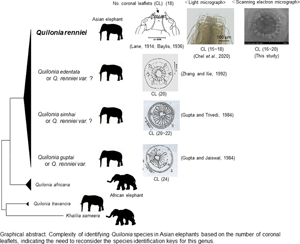No CrossRef data available.
Published online by Cambridge University Press: 13 December 2021

Although parasitic nematodes in the genera Murshidia and Quilonia (family Strongylidae) are recognized as major gastrointestinal parasites in Asian elephants, they have been poorly studied. Recently, light micrographs of these parasites in Myanmar have been presented, almost 100 years after the original drawings. However, the number of coronal leaflets, a key taxonomic feature of Quilonia species, has not been precisely determined based on light microscopy. The current study aimed to determine the exact number of coronal leaflets in Quilonia renniei specimens from Asian elephants in Myanmar. On the basis of scanning electron micrographs, leaflet number in females (19–20, average 19.7, n = 9) was significantly higher (P < 0.005) than that in males (16–19, average 18.1, n = 8). This compares with 18 coronal leaflets indicated in the original species description. Specimens bearing 19 coronal leaflets were most numerous, followed by those with 20 leaflets. Median-joining network analysis of mitochondrial cytochrome c oxidase subunit I gene sequences with 16 haplotypes from 19 individuals revealed no clear association between parasite populations and the number of coronal leaflets. These results highlight the importance of determining the number of coronal leaflets in the taxonomy of Q. renniei and other related Quilonia species infecting Asian elephants.